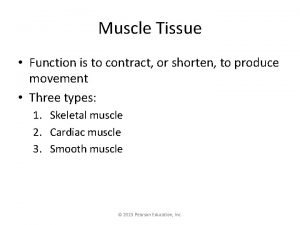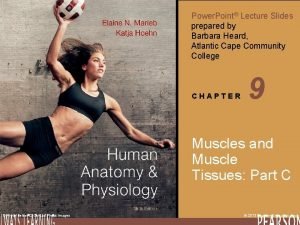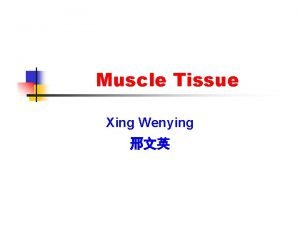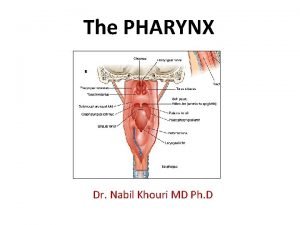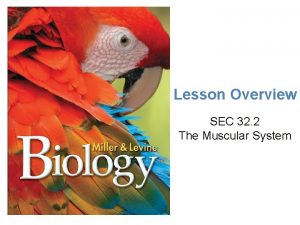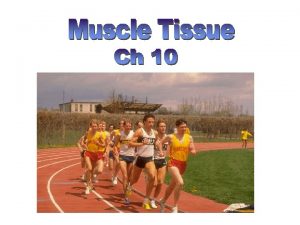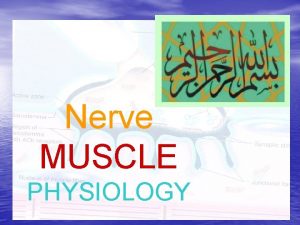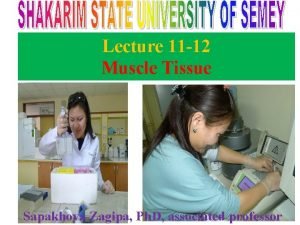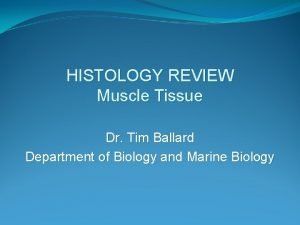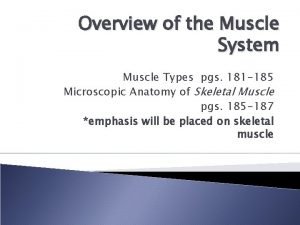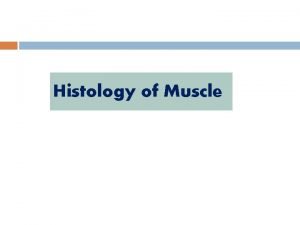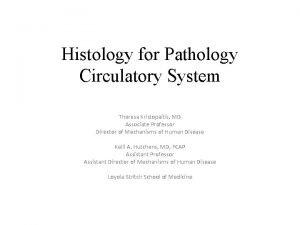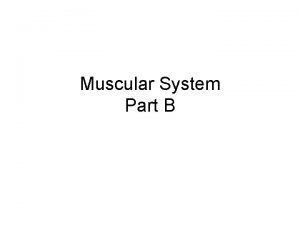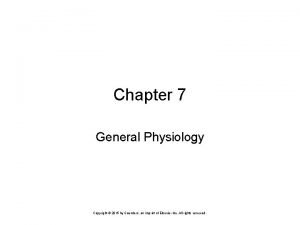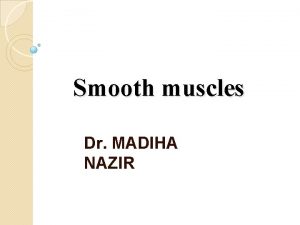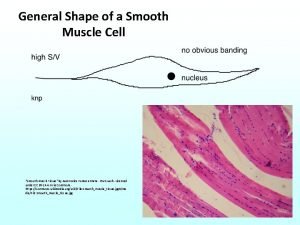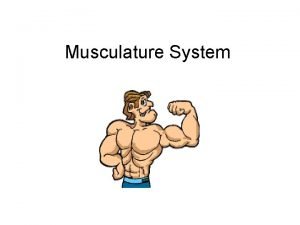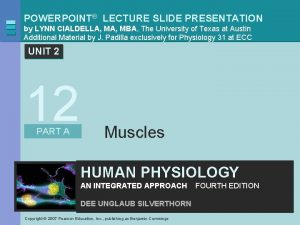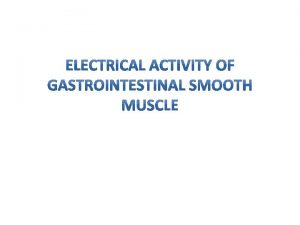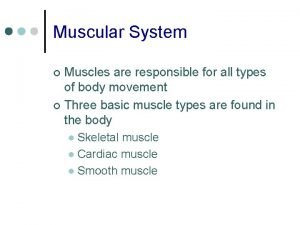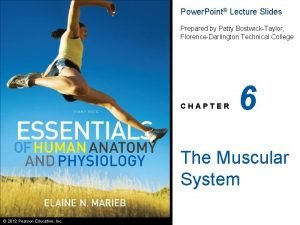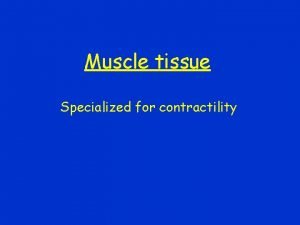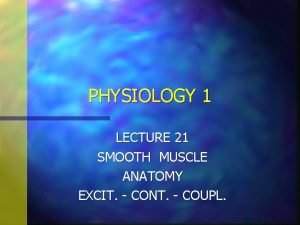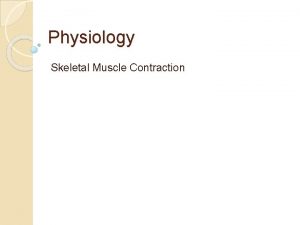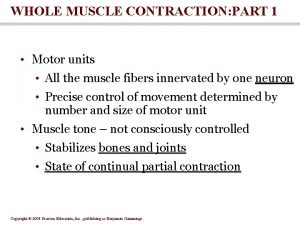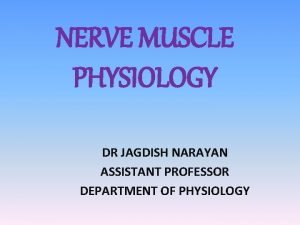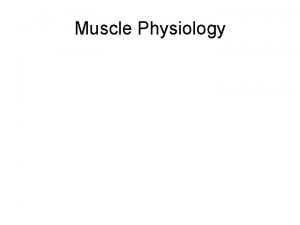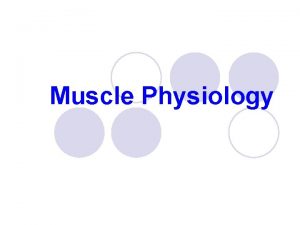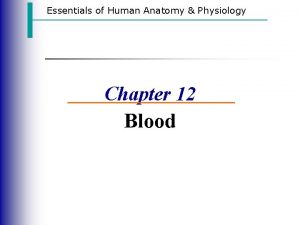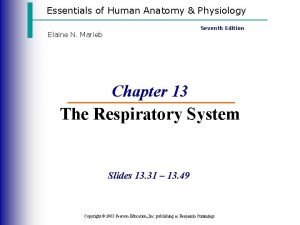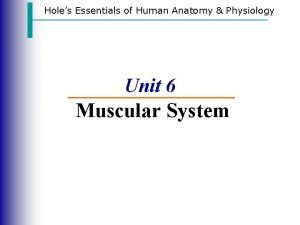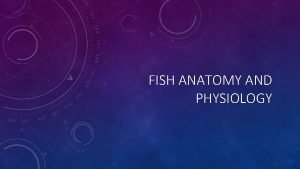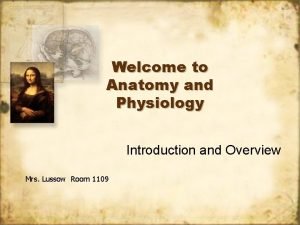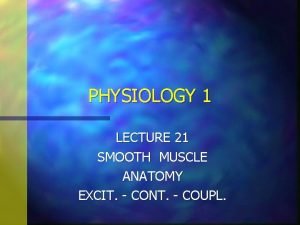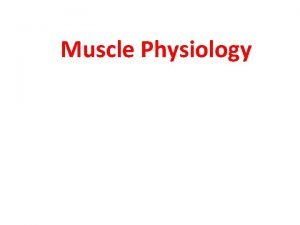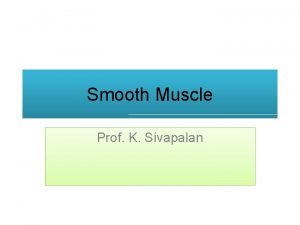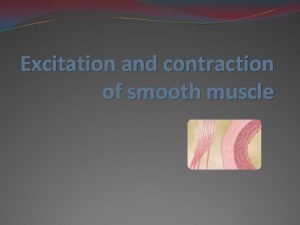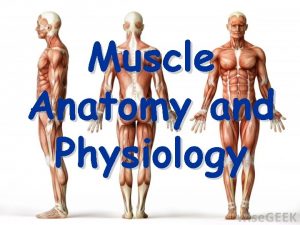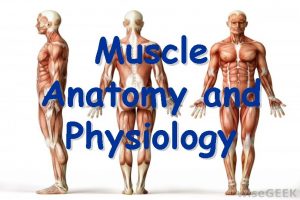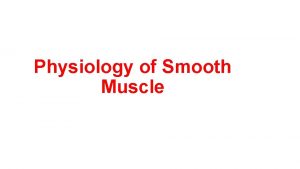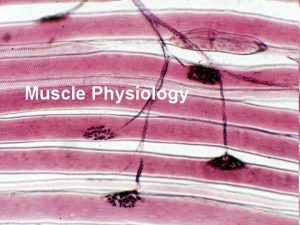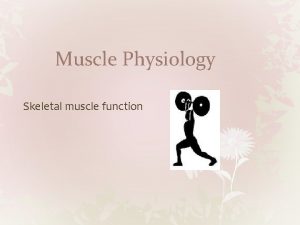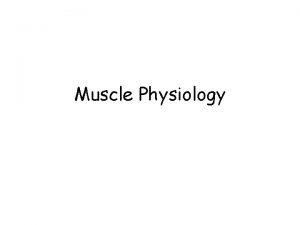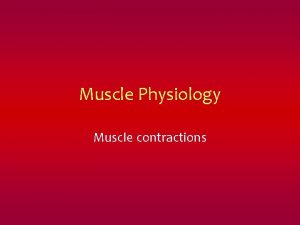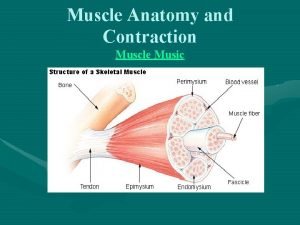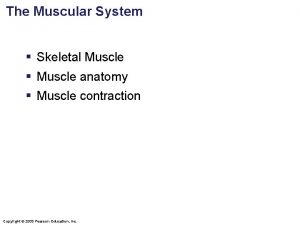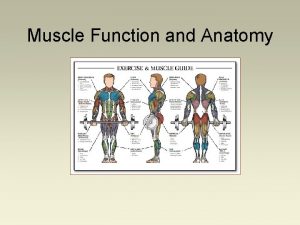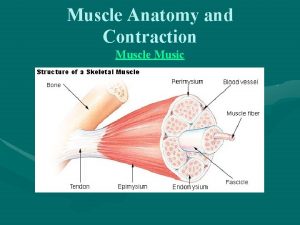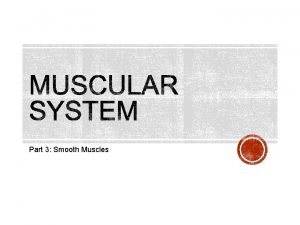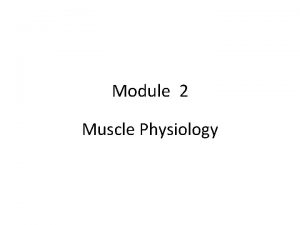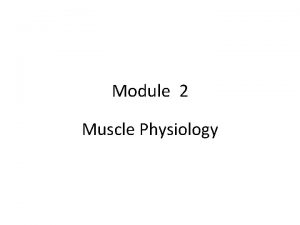PHYSIOLOGY 1 LECTURE 21 SMOOTH MUSCLE ANATOMY EXCIT















































- Slides: 47

PHYSIOLOGY 1 LECTURE 21 SMOOTH MUSCLE ANATOMY EXCIT. - CONT. - COUPL.

Smooth Muscle Anatomy n Smooth muscle is considered to be much more primitive than either cardiac or skeletal muscle. Muscle striations are not visible in smooth muscle, so the sarcomere relationship of myosin to actin does not exists in smooth muscle. However, per cross sectional area smooth muscle is as strong as skeletal muscle and smooth muscle is highly resistant to fatigue.

Smooth Muscle Anatomy n I. Smooth Muscle – 1. Fibers are smaller than skeletal muscle – 2. Involuntary (Usually) – 3. No apparent myofibrils under the light microscope - No cross striations – 4. Fibers are thickest in the middle and have tapered ends – 5. Centrally located single oval nucleus

Smooth Muscle Anatomy

Smooth Muscle Anatomy – 6. Sarcoplasm contains thick and thin filaments n a. Not in an orderly pattern n b. 10 – 20 times more thin filaments than thick filaments – 7. Dense bodies n a. Have thin filaments attached to them n b. Function is similar to Z disks n c. Dispersed throughout the sarcoplasm or attached to the sarcolemma n d. Thin filaments stretch from one dense body to another

Smooth Muscle Anatomy

Smooth Muscle Anatomy n B. Generation of Contraction – 1. Sliding filament mechanism involving thick and thin filaments generates tension that is transmitted to the thin filaments – 2. Does not contain Troponin complex – 3. Actin and myosin pull on the dense bodies attached to the sarcolemma – 4. Shortening of the smooth muscle fiber is lengthwise, the middle of the fiber thickens

Smooth Muscle Anatomy

Smooth Muscle Anatomy – 5. Shortening causes bubble like expansion of the sarcolemma – 6. Shortening is corkscrew like - the fiber twists in a helix as it shortens and rotates in the opposite direction as it lengthens

Smooth Muscle Anatomy Structure of Smooth Muscle II. Types of Smooth Muscle - Single unit and multi unit n Size - Smooth muscle is much smaller than either skeletal or cardiac muscle n Organization into bundles or sheets (Single unit) n Response to different types of stimuli n – Nerves, hormones, mechanical stretch, endothelial mediators (EDNO)

Smooth Muscle Anatomy Structure of Smooth Muscle Characteristics of innervation - Innervated by ANS - Swellings along the Axon are synapses Continuous firing the firing rate determines the concentration of neurotransmitter, hence the degree of physiological response n Function - Control the size of organs - cause the release of substances - Control the rate of flow (blood, contents of GI tract, urine) - etc. n

Smooth Muscle Anatomy Structure of Smooth Muscle n n n Types of smooth muscles Single Unit - Large aggregates of smooth muscle cells which act as a single unit. Multi Unit - Single smooth muscle cells usually with a single nerve connection

Smooth Muscle Anatomy Structure of Smooth Muscle n Multi Unit - Single smooth muscle cells usually with a single nerve connection Examples - Arrector pili muscles, Vas deferens and iris of the eye.

Smooth Muscle Anatomy Structure of Smooth Muscle n A. Multi-unit smooth muscle – 1. Individual fibers - independent of all other fibers – 2. Fibers contain their own motor neuron terminals with few gap junctions and control is mostly nervous – 3. Covered by a thin layer of basement membrane of fine collagen and glycoprotein fibrillae that help to insulate the fiber

Smooth Muscle Anatomy Structure of Smooth Muscle – 4. Action potential causes the stimulation of one single muscle fiber – 5. Seldom exhibit spontaneous contractions – 6. Found in: n a. Walls of large arteries n b. Airways of lungs (Bronchioles) n c. Arrector pili muscles attached to hair follicles n d. Radial and circular muscles of the iris of the eye

Smooth Muscle Anatomy Structure of Smooth Muscle n Single Unit - Large aggregates of smooth muscle cells which act as a single unit. . These usually line the hollow organs such as blood vessels or the gastrointestinal tract.

Smooth Muscle Anatomy Structure of Smooth Muscle n Single Unit - Unitary Smooth Muscle (Syncytial smooth muscle or visceral smooth muscle) – 1. Most common - sheets or bundles of large numbers of smooth muscle fibers that act as if they were a single unit (Syncytium) – 2. Cell membranes adhere to multiple points and gap junctions join cells (electrical continuity)

Smooth Muscle Anatomy Structure of Smooth Muscle – 3. Location; – a. Form part of the walls of both large and small arteries and veins n b. Hollow viscera - Stomach, intestines, uterus, urinary bladder – 4. Muscle forms large networks and an action potential causes contraction of the entire organ

Smooth Muscle Contractile Mechanism n C. Contractive Process in Smooth Muscle – 1. Chemical basis for smooth muscle contraction a. Contains actin and myosin filaments similar in structure and interaction to skeletal muscle n b. No troponin complex - mechanism for contraction is different n c. Calcium influx activates the contractile process n

Smooth Muscle Contractile Mechanism E. Major differences between smooth muscle and skeletal muscle n Physical organization of smooth muscle n Excitation-contraction-coupling n Control of the contraction process by calcium n Duration of contraction n Amount of energy required for contraction n – 2. Physical basis for smooth muscle contraction

Smooth Muscle Contractile Mechanism A. Smooth muscle is not striated n b. Dense bodies - attachment for actin fibers - some attach to cell membrane others located throughout the cytoplasm dense bodies in one cell may join with a dense body in the adjacent cell n c. Few myosin fibers are located in the actin fibers (15: 1 ratio of actin to myosin) n


Smooth Muscle Contractile Mechanism n 3. Comparison of smooth muscle contraction with skeletal muscle contraction – a. Starts slower and lasts longer than striated muscle fiber, smooth muscle has a prolonged contraction - up to hours to days – b. Can shorten and stretch to a greater extent than striated muscle – c. Contraction is initiated by calcium influx into the sarcoplasm (Outside Calcium)

Smooth Muscle Contractile Mechanism – D. Sarcoplasmic reticulum in smooth muscle is sparse - 3 to 5 % of cell volume – e. Calcium flows into sarcoplasm from extracellular fluid – f. No T-tubules in smooth muscle - Therefore, calcium movement is slow – g. Smooth muscle tone - occurs due to the slow movement of calcium from the cell – h. Smooth muscle has less ATPase activity and therefore, less degradation of ATP

Smooth Muscle Contractile Mechanism – I. Smooth muscle only needs 1/10 to 1/300 of the energy that skeletal muscle requires – j. Only one ATP is required per contraction cycle no matter how long it lasts – k. Smooth muscle reaches full contraction about 1/2 second after stimulation – l. Contractile force reaches maximum within 1 - 2 seconds after stimulation

Smooth Muscle Contractile Mechanism – M. Rate of contraction is 30 times slower than skeletal muscle – n. Contractions can last from 0. 2 to 30 seconds – o. Smooth muscle force of contraction can be approximately 2 X that of skeletal muscle – p. Smooth muscle can shorten to a greater degree than skeletal muscle reduces lumen of organs to almost zero

Smooth Muscle Contractile Mechanism n 4. “Latch Mechanism - prolonged holding in smooth muscle – a. After contraction is initiated, less stimulus and energy are needed to maintain the contraction (Energy conservation) – b. Can maintain prolonged tonic contractions for hours with little energy and little excitatory signal from nerves or hormones

Smooth Muscle Contractile Mechanism – C. Mechanism: lower activation of enzymes, myosin head remains attached to actin for long periods of time but large numbers are attached and the force is great n 5. Stress - Relaxation of Smooth Muscle – Important characteristic of visceral smooth muscle

Smooth Muscle Contractile Mechanism n Stress - Relaxation response - ability to return nearly to the original force of contraction seconds to minutes after it has been elongated or shortened – a. When smooth muscle is initially stretched - it will contract and increase tension (Myogenic response) – b. Smooth muscle fibers can stretch and still maintain their contractile function

Smooth Muscle Contractile Mechanism – C. Smooth muscle can undergo great changes in length and still retain the ability to contract effectively – d. This response allows vessels and hollow organs to change size but maintain the pressure within the structure at a constant level (Probably related to the “latch mechanism”)

Smooth Muscle Contractile Mechanism – D. Regulation of Contraction by Calcium Ions n a. ICF calcium is the initiating event for smooth muscle contraction n b. An increase in calcium influx can be caused by: nerve stimulation, hormones, chemical changes in the environment (Ligands), and mechanical stretch of the fiber

Smooth Muscle Contractile Mechanism n 2. Role of calmodulin in excitationcontraction-coupling in smooth muscle – a. Smooth muscle has no Troponin but it does have a regulatory protein called calmodulin – b. Calmodulin is similar in structure to Troponin and like Troponin combines with 4 calcium ions causing activation – c. Activated calmodulin-Ca++ complex activates myosin light chain kinase

Smooth Muscle Contractile Mechanism

Smooth Muscle Contractile Mechanism – d. The activated myosin light chain kinase phosphorylates the myosin light chains (regulatory proteins on the myosin heads) using an ATP unit – e. The myosin heads now engage actin and cross bridge cycling proceeds using the same process as in skeletal muscle – f. Cessation of contraction n 1. As [Ca++] drops below a critical level n 2. Myosin phosphatase removes the phosphate from the myosin light chains and contraction

Smooth Muscle Contractile Mechanism

Smooth Muscle Contractile Mechanism n n Regulation of the myosin light chain and smooth muscle contraction While the MLCK adds a P group to the MLC dependent on [Ca++] myosin light chain phosphatase removes it deactivating the myosin head. The phosphatase is continually active.

SMOOTH MUSCLE STIMULATION Smooth muscle responds to stimulation from a number of different physiological systems. n 1. Nerves n 2. Hormones n 3. Mechanical manipulation n 4. Self stimulation (Automaticity) n

SMOOTH MUSCLE Neural-Muscular Junction

SMOOTH MUSCLE STIMULATION n 2. Excitatory and inhibitory transmitter substances at NMJ – a. Ach & norepinephrine are never secreted by the same nerve fiber – b. Ach can be excitatory or inhibitory - determined by the type of receptor expressed by the target cell – c. Ach and NE usually cause the opposite reaction at a target cell (If Ach is stimulatory then NE will most likely be inhibitory)

SMOOTH MUSCLE STIMULATION Unitary n B. Membrane Potential and AP in smooth muscle (Slow waves and Spike Potentials) – 1. Unitary smooth muscle n a. Slow waves - In smooth muscle the resting membrane potential is variable - usually about 50 to -60 m. V n b. Variable resting membrane potential is called the basic electrical rhythm or BER or sometimes slow waves

SMOOTH MUSCLE STIMULATION Unitary

SMOOTH MUSCLE STIMULATION Unitary – B. Slow waves and spontaneous generation of action potentials n 1. Slow waves are not action potentials - they are local unstable resting membrane potential and they determine the rhythmicity of smooth muscle contractions n 2. Slow waves can initiate true action potentials called spike potentials (Ca++ voltage gated) n 3. Spike potentials are generated whenever BER exceeds threshold about -35 m. V

SMOOTH MUSCLE STIMULATION Unitary n Spike Potentials – a) Spike potentials cause rhythmic contractions of smooth muscle – b) Increase the number of spike potentials and increase the force of smooth muscle contraction – c) Regulation - mechanical stretch, hormones, and Ach cause membrane to become less negative (Hypopolarize the cells)

SMOOTH MUSCLE STIMULATION Unitary

Depolarization of Multiunit Smooth Muscle w/o AP – Smooth muscle contraction in response to local tissue factors – 1) Arterioles, metarterioles & precapillary sphincters have little or no nerve supply – 2) Highly contractile smooth muscle responds rapidly to local factors n Lack or a decrease in O 2 levels - Increase in CO 2 - Increase in hydrogen ions - Decrease in ECF Ca++ - Adenosine or increased lactic acid – Cause Vasodilation

Depolarization of Multiunit Smooth Muscle w/o AP n C. Effect of hormones on smooth muscle contraction – 1) Most hormones affect smooth muscle through second messengers – 2) Important hormones - Norepinephrine, Ach, angiotensin II, oxytocin, vasopressin, serotonin and histamine – 3) Action of hormones is controlled by the type of receptors expressed by the target cell - hormone (Ligand) gated excitatory and inhibitory receptors (Ca++ or K+ channels)

Smooth Muscle SUMMARY n 1. How does smooth muscle differ from skeletal muscle? n 2. How is excitation contraction coupling control different in smooth muscle from skeletal muscle? n 3. What are slow waves or BER and spike potentials? n 4. How is BER controlled? n
 Smooth muscle cells
Smooth muscle cells Smooth muscle
Smooth muscle Slide
Slide T tubules
T tubules Pharyngeal fascia
Pharyngeal fascia Function of skeletal muscle
Function of skeletal muscle Isotonic exercise
Isotonic exercise Cardiac skeletal and smooth muscle comparison
Cardiac skeletal and smooth muscle comparison Ginus
Ginus Function of muscle
Function of muscle Comparison of skeletal cardiac and smooth muscle
Comparison of skeletal cardiac and smooth muscle Muscle histology review
Muscle histology review Comparison of skeletal cardiac and smooth muscle
Comparison of skeletal cardiac and smooth muscle Cardiac muscle tissue
Cardiac muscle tissue Large artery histology
Large artery histology Smooth muscle gap junctions
Smooth muscle gap junctions Smooth muscle
Smooth muscle Which muscle is striated in appearance but resembles smooth
Which muscle is striated in appearance but resembles smooth Varicosities of smooth muscle
Varicosities of smooth muscle Smooth muscle
Smooth muscle Smooth muscle under the microscope
Smooth muscle under the microscope Transverse tubules and sarcoplasmic reticulum
Transverse tubules and sarcoplasmic reticulum Smooth muscle
Smooth muscle Tetany vs tetanus
Tetany vs tetanus Myosin in smooth muscle
Myosin in smooth muscle Characteristic of smooth muscle
Characteristic of smooth muscle Characteristics of skeletal smooth and cardiac muscle
Characteristics of skeletal smooth and cardiac muscle Supporting connective tissue
Supporting connective tissue Nucleus of smooth muscle fiber in cross-section
Nucleus of smooth muscle fiber in cross-section Smooth muscle
Smooth muscle Microbial physiology notes
Microbial physiology notes Cross bridge myosin head
Cross bridge myosin head Terminal cisternae
Terminal cisternae Nerve muscle physiology
Nerve muscle physiology Muscle physiology
Muscle physiology Treppe
Treppe 01:640:244 lecture notes - lecture 15: plat, idah, farad
01:640:244 lecture notes - lecture 15: plat, idah, farad Anatomy and physiology of the retina
Anatomy and physiology of the retina Anatomy and physiology chapter 15
Anatomy and physiology chapter 15 Figure 10-1 blood
Figure 10-1 blood Science olympiad anatomy and physiology 2020 cheat sheet
Science olympiad anatomy and physiology 2020 cheat sheet Physiology
Physiology Anatomy and physiology
Anatomy and physiology Appendicitis anatomy and physiology
Appendicitis anatomy and physiology Biceps muscle names
Biceps muscle names Fish anatomy and physiology
Fish anatomy and physiology Welcome to anatomy and physiology
Welcome to anatomy and physiology Anatomy and physiology bone
Anatomy and physiology bone

